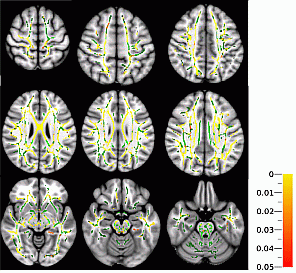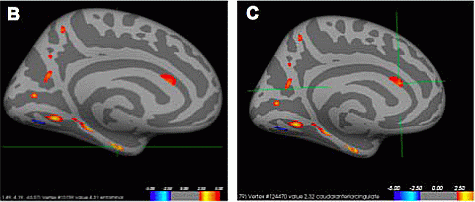BSPED2016 Oral Communications Oral Communications 5- Endocrine (8 abstracts)
Functionally significant reductions in white matter in patients with congenital adrenal hyperplasia
Emma Webb 1, , Lucy Elliott 1 , Dominic Carlin 1 , Martin Wilson 1 , Kirsty Hall 1 , Timothy Barrett 1, , Vijay Salwani 4 , Wiebke Arlt 1, , Nils Krone 3 , Andrew Peet 1, & Amanda Wood 1
1University of Birmingham, Birmingham, UK; 2Birmingham Childrens Hospital, Birmingham, UK; 3Sheffield Children’s Hospital, Sheffield, UK; 4University Hospital Birmingham, Birmingham, UK.
Background: Management of patients with CAH remains challenging. There is increasing evidence to suggest that failure to optimize treatment during childhood not only affects final height but also leads to psychological and psychiatric problems, reflecting an underlying effect on neural development. Previous qualitative structural T2-weighted MRI studies have identified white matter hyper-intensities in up to 46% of CAH patients. The nature and functional relevance of these abnormalities remains unknown.
Objective and hypotheses: We aimed to identify novel MRI brain biomarkers of CAH using quantitative imaging and to examine their association with cognitive abnormalities.
Method: All participants completed subtests of the Cambridge Neuropsychological Test Automated Battery and underwent brain volumetric, magnetic resonance spectroscopy and diffusion tensor imaging. Freesurfer (neural volumes and cortical thickness), TARQUIN (metabolites) and Tract Based Spatial Statistics (fractional anisotropy) were used for neuroimaging data analyses. ANCOVA were performed to compare groups, adjusted for multiple comparisons. Partial correlations were performed to assess the relationship between MRI markers and neuropsychological measures controlled for age and socioeconomic status.
Results: Seventeen females with 21-hydroxylase deficiency and eighteen age-matched healthy females were recruited (32.7 and 28.6 years, P=0.25). Patients with CAH had significantly lower episodic memory, learning and spatial working memory (P<0.001) scores. Chiari 1 malformations (defined as downward displacement of>5 mm of the cerebellar tonsils through the foramen magnum) were identified in 4 of the 17 patients. Patients with CAH had significant reductions in total brain volume (P=0.02), corpus callosum volume (P−0.03), hippocampal N-Acetyl Aspartate (P=0.03) and choline (P=0.002), brain fractional anisotropy (Figure A, P<0.01) and parahippocampal cortical thickness (B, left, C, right, P<0.05). There were significant relationships between; corpus callosum volume and spatial working memory (P=0.001), parahippocampal thickness, episodic and working memory (P<0.05), hippocampal choline and rapid visual information processing (P<0.02).
Conclusion: For the first time we have identified central nervous system imaging biomarkers of clinically significant cognitive abnormalities in patients with CAH. Further studies are required to determine the age of onset of these abnormalities and to develop preventative strategies.
A. Mean FA skeleton overlaid on the mean FA map. Regions of the mean FA skeleton in green represent areas where there were no significant differences in FA values in the patients with CAH compared to controls. Areas in red/yellow are regions where the FA was significantly lower in the CAH group. Colour map indicates the degree of significance for red and yellow regions.
QDEC analysis demonstrating significant reductions in parahippocampal cortical thickness in female patients with CAH compared to controls.
Areas in red/yellow are regions where cortical thickness is significantly lower in the CAH group in the left (B) and right (C) hemisphere. Green lines indicate the parahippocampal region.



 }
}



